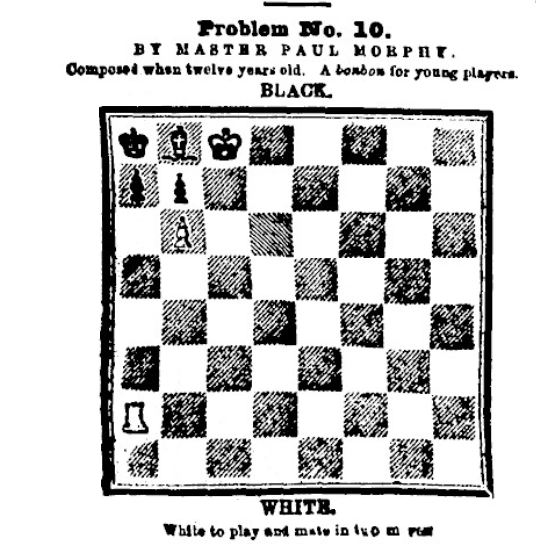A Paul Morphy's puzzle

Wow il puzzle di Morphy è semplice da risolvere, ma geniale solo un campione come lui poteva pensare ad un matto con deviazione sacrificando la torre per poi avanzare col pedone per vincere.
Leonardo Riviero

Hello everybody, please help me solve this puzzle
By Paul Morphy, 1856.
It's rook A6! And then black is forced to play bishop c7 or if he takes the rook pawn b7 is mate. After bishop c7, rook a7 is mate
White to play and mate in two moves.

It is safe to say that the OP probably figured that out in the past 13 years. For example, he might have read one of the dozen comments that told him the same.

It is safe to say that the OP probably figured that out in the past 13 years. For example, he might have read one of the dozen comments that told him the same.
I did not. I sat there for 30 minutes looking at every possible combination and no one else figured that out here.

Morphy was 10 years old when he invented this puzzle, his only known composition. The position is simple but cunning. The text reads "White to play and mate in two moves." and indeed White can, but only if you discover Morphy's surprise move--a move that will delight aficionados and beginners alike.

It is written that Morphy was 12 years old when he composed his puzzle. But it was first published on June 28, 1856 in the New York Clipper when Morphy had just turned 19 (a birthday present, maybe?!). In the 19th century, time passed more slowly and it was possible to postpone publication painlessly for as much as 7 years! ![]()

I believe Morphy could have been 10 or 12. Anyone with a talent for composition will start with simple beauties like this one. My first 2 compositions turned out to be remakes of older gems. That was Morphy's advantage. In the 19th century much was yet undiscovered! Had he not found it, someone else would have in the next 25 years!

I believe Morphy could have been 10 or 12. Anyone with a talent for composition will start with simple beauties like this one. My first 2 compositions turned out to be remakes of older gems. That was Morphy's advantage. In the 19th century much was yet undiscovered! Had he not found it, someone else would have in the next 25 years!
The idea was already in the air. Half a year before the publication of Morphy, a problem of the famous E.B. Cook of Hoboken appeared in the Illustrated London News. You can find similar motifs in it.


he idea was already in the air. Half a year before the publication of Morphy, a problem of the famous E.B. Cook of Hoboken appeared in the Illustrated London News. You can find similar motifs in it.
This is of course the better version but much too hard for the chess.com softies ![]()

I've seen this before... : 1. Ra6 bxd6 2. b7# or 1...Bc7 (or pretty much anywhere else for that matter) and 2.Rxa7. Nice!




Rook a6 ofc then forced mate in 1